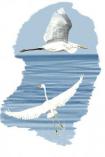Great White Egret - Casmerodius albus
The Great Egret is perhaps the heron that has spread its distribution the most.
Only a few years ago is was one of the rarest herons in Italy, hardly ever seen and then only in winter, but now it is found in considerable numbers not only in the great wetlands but also in the country and on reclaimed land with human settlements.
A large bird, it is almost the same size as the Grey Heron. Looking like a larger version of the Little Egret and entirely white, it could be confused with the latter, but on closer inspection their size difference leaves no doubt.
In addition, unlike the Little Egret, except during the nesting season, the Great Egret sports a yellow beak the whole year through which makes it easy to recognise.
During the breeding season, the Great Egret assumes its nuptial livery with long “egrets” (long floating feathers) on its flanks and back.
Just like the Little Egret, over the past few years the Great Egret has begun to breed in many Italian fenland areas, and indeed about ten pairs nest in the Fucecchio Marshes.
Although it also nests on trees and bushes, at Fucecchio Marshes the colony has settled in a mature reed thicket.
There are far more individuals of this species during winter, when our country offers a home to overwintering contingents arriving from other northern and eastern European countries; in winter it is not unusual to see the Great White Egret in fields, where it often feeds.




